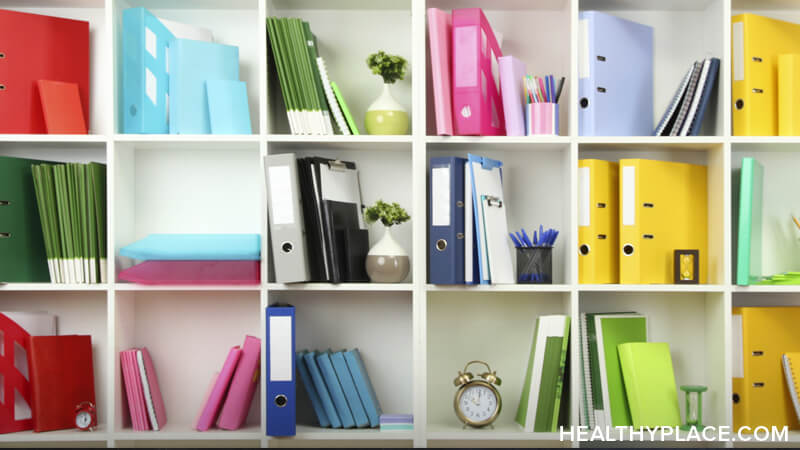ADHD and Clutter: 5 Tips for Getting Organized

ADHD and clutter naturally occur together, and together they make a natural disaster. One of the hallmarks of ADHD is disorganization; because of symptoms like distractibility and difficulty focusing, organization is a difficult task for people living with ADHD. Clutter builds. Then, because of the clutter, ADHD symptoms of distractibility and difficulty focusing increase. It’s the perfect, intensifying storm.
For someone with ADHD, a sense of wellbeing can get buried under all the clutter. A cluttered environment decreases overall mental health and increases stress (Whitbourne, 2017). The idea of organizing can be overwhelming, and the temptation to procrastinate or avoid organizing makes sense. But with the right approach, you can eliminate clutter and get organized.
ADHD and Clutter: Two Basic Principles of Organization
When you begin to declutter and take control of your own space, everything can blur together into one gigantic overwhelming pile of mess. Before diving into the five tips for getting organized, there are two general principles to guide you:
- The one-year principle. If you haven’t used, worn, or otherwise noticed something in a year, get rid of it.
- The OHIO method. This principle helps you cut down on paper clutter. Regarding paperwork, Weiss (2005) advises, Only Handle It Once. Act immediately on things like bills or notes kids bring home in backpacks. Deal with it, then file or recycle. This works for things other than paper, too, like small objects that end up on counters and tabletops. Handle it once, then toss, recycle, or donate.
Five Tips for Getting Organized, Reducing ADHD Clutter
These tips are easy-to-follow solutions to clutter. De-cluttering using these strategies will help you feel less overwhelmed and more in control of yourself and your space.
- Begin with vision and purpose. Without meaning, decluttering can seem pointless and tedious, and it will be easy to get distracted and walk away. Borrowing from solution-focused therapy, ask yourself what your space will be like when it’s neat, organized, and clutter-free. What will you be able to do and enjoy in this clean space?
- Break it into bits. It can be paralyzing to look at every corner of disorganization and think of trying to tackle it all. On top of that, ADHD makes it difficult to start tasks and to concentrate on them. Break your tasks up and tackle your decluttering bit by bit.
- Be methodical. Even when organizing in bits, it can be hard to know where to begin and ADHD can cause you to jump around, starting something but moving on before finishing. A solution to your clutter is to have a plan and a system. Go room by room, perhaps, and within each room sort by types of items.
- Schedule time for decluttering. Creating schedules is a helpful tool for people living with ADHD. Scheduling time for important people and tasks ensures that you follow through rather than forgetting and feeling bad later. Scheduling works for organization because it ensures that you’ve dedicated time to do it. Make sure, too, to schedule breaks and stop times (Adult ADHD and How to Manage Your Time and Stay on Schedule).
- Buddies and Breaks. Enlist the assistance of a friend or family member. Tackling a tedious task with someone else makes it more enjoyable. Plus, you’ll have someone to help keep you on track and help you sort things into piles for keeping, donating, recycling, or tossing. Throughout the process of getting organized, be sure to take breaks. Breaks will keep you fresh and motivated.
These general tips can be applied to any organization project. Together, they provide ADHD-friendly solutions to clutter.
Eliminate Clutter When You Have ADHD
As you employ the above tips for getting organized, you also want to create places to put the things you’re keeping so they are easily accessible and don’t contribute to more clutter. If you have a place for everything, your living and working space will be more likely to stay neat, and you won’t be caught in a frantic dash to find something at the last minute. (Imagine not having to search for keys when you’re supposed to be leaving the house.)
To organize your space:
- Use different colored folders for the various things you have to keep track of, such as papers from school, insurance information, etc.
- Use accordion folders to file things like coupons, tickets, etc.
- Have colorful baskets or bowls in strategic places, such as on a table by the door, a coffee table, or the stairs. Make them a regular part of your life by always placing the same items in them. Keys will always go by the door. Reading glasses will be placed where you use them the most.
If clutter has taken over your life, chances are your adult ADHD symptoms feel heightened because ADHD and clutter contribute to each other. Manage both your symptoms and your life by eliminating clutter.
APA Reference
Peterson, T.
(2021, December 20). ADHD and Clutter: 5 Tips for Getting Organized, HealthyPlace. Retrieved
on 2025, November 27 from https://www.healthyplace.com/self-help/adhd/adhd-and-clutter-5-tips-for-getting-organized



